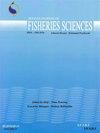Influence of dietary nucleotides on growth performance and stress resistance in Kutum (Rutilus kutum Kamenskii, 1901)
IF 0.6
4区 农林科学
Q3 FISHERIES
引用次数: 0
Abstract
A feeding trial has been conducted to evaluate the effects of dietary nucleotide (NT) on growth performance and stress resistance of fry kutum (Rutilus kutum Kamenskii, 1901). A basal diet supplemented with 0 (control), 0.3, 0.5 and 0.7 g NT kg-1 have been formulated for four experimental diets. After 8 weeks of feeding trial, growth parameters were evaluated and then fish has exposed to osmotic stress. To elucidate the underlying physiological mechanisms, cortisol, apoptosis and HSP70 levels were measured at selected times of 0, 2 h, 8 h and 24 h after the osmotic shock. The results revealed dietary NT feed exerts a positive effect on the growth performance of kutum fries and fish fed with 0.7 g NT kg-1 had the highest final weight compared with other treatments (p<0.05). Results of HSP70 showed that fish fed with NT had higher levels of HSP70 expression. Also, the levels of HSP70 at 2 h increased significantly, 3-7-fold over baseline levels (0 h) and then decreased significantly at 24 h, however HSP70 levels at 24 h was 1-3-fold over baseline levels. Apoptosis and cortisol values were affected by dietary NT levels and all NT groups showed lower stress-induced apoptosis and cortisol elevation, compared to control group.日粮核苷酸对库姆鱼生长性能和抗逆性的影响(Rutilus Kutum Kamenskii, 1901)
为了评价日粮核苷酸(NT)对kutum鱼苗生长性能和抗逆性的影响,进行了一项饲养试验(Rutilus kutum Kamenskii,1901)。为四种实验日粮配制了添加0(对照)、0.3、0.5和0.7g NTkg-1的基础日粮。在8周的饲养试验后,评估生长参数,然后将鱼暴露于渗透应激。为了阐明潜在的生理机制,在渗透休克后0、2、8和24小时的选定时间测量皮质醇、细胞凋亡和HSP70水平。结果表明,NT日粮对炸薯条的生长性能有积极影响,与其他处理相比,添加0.7g NT kg-1的鱼的最终体重最高(p<0.05)。HSP70检测结果表明,添加NT的鱼HSP70表达水平较高。此外,HSP70的水平在2小时时显著增加,是基线水平(0小时)的3-7倍,然后在24小时时显著降低,但24小时时的HSP70水平是基线水平的1-3倍。细胞凋亡和皮质醇值受饮食NT水平的影响,与对照组相比,所有NT组均表现出较低的应激诱导的细胞凋亡和皮质类固醇升高。
本文章由计算机程序翻译,如有差异,请以英文原文为准。
求助全文
约1分钟内获得全文
求助全文
来源期刊

Iranian Journal of Fisheries Sciences
FISHERIES-
CiteScore
2.30
自引率
11.10%
发文量
0
审稿时长
3 months
期刊介绍:
1- Living various species (contains animals and vegetal species) in various aquatic ecosystems.
2- Health and diseases of aquatic species.
3- Determining the stocks and specific time and location for catching and reliable exploitation for sustainable development.
4- Methods of propagation and culture of high value aquatic resources.
5- Aquatic stock assessment and the methods of restocking the high value species and suggestion for rate, areas and the time for releasing fish and other aquatic organisms fries.
6- Pollutant agents and their effects to the environments of aquatic species.
7- Feed and feeding in aquatic organisms.
8- Fish processing and producing new products.
9- The economic and social aspects of fisheries.
 求助内容:
求助内容: 应助结果提醒方式:
应助结果提醒方式:


